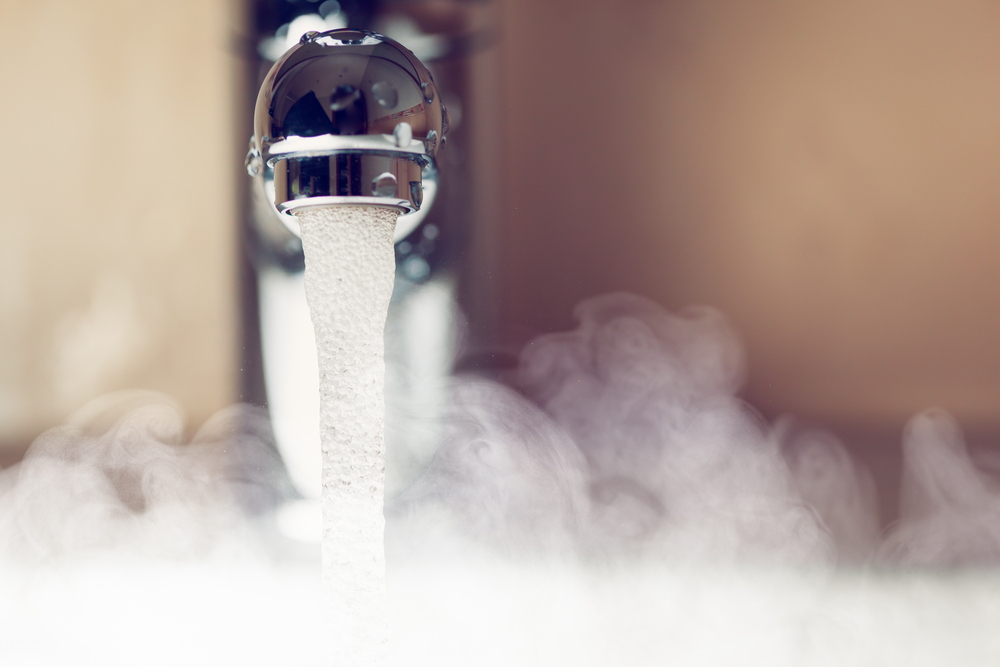
There’s nothing like pouring a nice clear glass of water, but what if the water is not as clear as you’d hoped? Cloudy water is not an uncommon occurrence, especially if it’s hot water.
Since it’s the hot water that’s mainly affected, you may blame the water heater first, and although the water heater may be to blame, there are also other possibilities. Read on to find out what causes cloudy water and some simple ways to fix it.
What Causes Cloudy Water?
Water molecules consist of hydrogen and oxygen. When heated, they expand. During expansion, other molecules and smaller particles are trapped, which causes the water to look cloudy. Essentially, bubbles created during the expansion are what cause the cloudy look. So why doesn’t the water always look cloudy? Pressure.
The buildup – and sudden release – of pressure is what causes the separation of molecules, which in turn creates bubbles. Note that air bubbles created this way are not the same thing as air in your hot water lines. Also, pressure isn’t the only culprit.
Here are some common causes:
Dirty Aerator
The aerator is found at the tip of the faucet. You can usually twist it off easily. When sediment builds up and blocks the path of flowing water, it creates unwanted pressure. This pressure creates more bubbles and makes the cloudy look in the water.
Sediment Buildup in the Water Heater
Sediment will build up in your water heater, and the only way to limit this is by flushing the hot water heater or using a water filtration system. Sediment gathers on the anode – or element – and limits its potential.
Eventually, the sediment flakes off and settles to the bottom of your water heater. It continues to accumulate over the years until it’s flushed or it eats through the bottom of your water heater.
Heating Up the Water
Heating the water will likely produce cloudiness. If you look into a pot of water on the stove, you’ll see it cloud over from the bubbles. Depending on how hot you have your hot water heater set, it could produce the same effect from your faucet.
The Rare Winter Effect
It’s not common, but water on the verge of freezing can cause cloudiness. There aren’t many freezing days in Plano, but it does happen. If you look at the cloudiness in a piece of ice, you can see the effect cold has on water. Cloudiness in cold water may be a sign of something serious or that you need to insulate your pipes better.
Outside Sources
You may not have cloudy water, but instead, it may look tinted or even muddy. If your municipality is doing work to the outside pipes, there is a chance you may get some ugly-looking water, but it shouldn’t last for more than a couple of hours.
If you notice irregularities after heavy rain, then there may be something wrong with your pipes, and you should call a professional plumber immediately.
How to Determine if Your Cloudy Water Is a Concern
Cloudy water could be nothing, but it could also be serious. Luckily, there is a simple method to determine whether your cloudy water is a concern.
- Get a see-through container. This container can be a glass, bowl, or Mason jar.
- Turn on your water till it’s hot.
- Fill the container to at least three-quarters of the way full.
- Set the container on a flat surface and watch it.
Air is lighter than water and will rise to the top. If the cloudiness is primarily air, you will notice the bottom of the container clears, and the rest of the container will be void of cloudiness within a couple of minutes.
Sediment is heavier than water and will settle to the bottom of the container. With sediment, the top of the container will clear first. It will also take much longer for the container to clear since the hot water makes it difficult for the sediment to reach the bottom.
How You Can Fix Cloudy Water in Your Plano Home
Though it’s easy to blame the water heater, it’s actually the aerator that’s to blame in many cases. One of the simplest ways to find out and possibly even fix the problem is by removing and cleaning the aerator. To do this:
Remove The Aerator From The Faucet
The aerator should unscrew from the faucet by turning clockwise. You may need to use a wrench if it won’t come off easily using your hands. If you can’t remove it by hand, it’s best to contact a professional plumber, as they can remove it without causing damage.
Clean The Aerator
After you’ve removed the aerator, give it a thorough visual inspection for any dirt and debris that may be caked onto it. Use a washcloth to remove the loose gunk.
There are small mesh holes inside the aerator where sediment deposits can get lodged. Use a toothpick, paper clip, or small needle to dig them out. If they aren’t coming out easily, or you want to be thorough, soak the aerator in white vinegar overnight to loosen the debris.
Rinse It Out
Once the aerator is cleaned out, give it a good rinsing before placing it back onto the faucet. Hold the aerator under running water to rinse away any lingering debris that became loosened and may be trapped within it.
Replace The Aerator
When it’s clean and all ready to go, simply screw the aerator counterclockwise back onto the faucet using your hands to get it as tight as it will go.
Test The Water
It’s time to see if your efforts paid off. Turn on the hot water and allow it to run for a minute to see if the water is still cloudy. If it is, it means there’s a bigger issue at hand, likely something to do with your hot water heater. A plumbing professional will need to come in and inspect the hot water heater to help diagnose the problem.
Plano’s Plumbing Experts
Tired of dealing with cloudy water in your Plano, TX, home? The plumbing specialists at Sirius Plumbing and Air Conditioning are standing by, ready to take your call.
With a “Fixed Right and Left Better Than We Found it Guarantee” and a “100% money-back guarantee on all heating, plumbing, and air conditioning issues, you can trust that the job will be handled right the first time, every time. Contact us today to learn more or to schedule an appointment!
